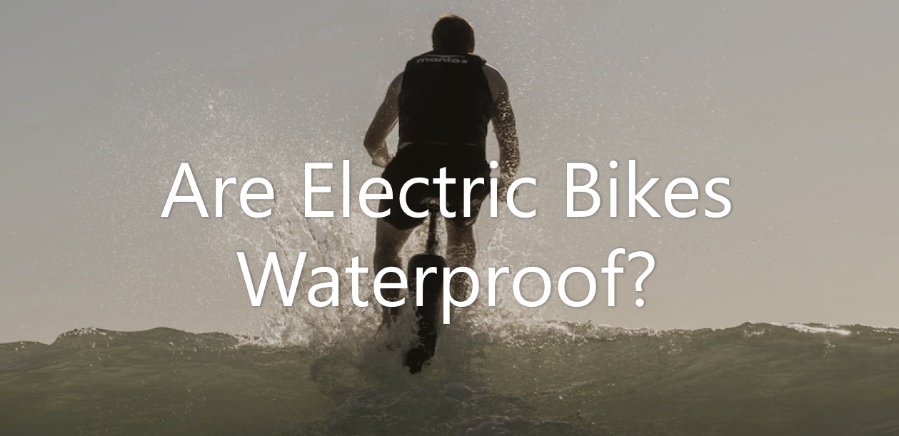Are Electric Bikes Waterproof?

As electric bikes, also known as e-bikes, continue to gain popularity, potential buyers and current owners often have numerous questions about their use, maintenance, and durability. One of the most common queries is: “Are electric bikes waterproof?” Given the blend of electronics and mechanics within an e-bike, it’s a reasonable question to ask. This article aims to shed light on the water resistance of e-bikes and provide insights into their ability to withstand different weather conditions.
Unveiling the Electric Bike
E-bikes are essentially regular bicycles fitted with an electric motor, a battery, and a controller, all of which help to assist with pedaling. Some e-bikes also include an integrated display to monitor speed, battery level, and other parameters. This combination of mechanical and electronic components means that e-bikes are somewhat more sensitive to the elements than regular bicycles.
So, Are E-Bikes Waterproof?
The short answer is: Not entirely, but they are usually designed to be water-resistant to a certain extent. This means they should be able to endure light to moderate rain without any significant impact on their performance or their electronic components. Most e-bike manufacturers design their products to withstand typical weather conditions, and many components, such as the motor, display, and battery pack, have some form of water protection.
The International Protection Marking (IP) code is a standard used to define the levels of sealing effectiveness of electrical enclosures against intrusion from foreign bodies and moisture. E-bike components typically come with IP ratings that tell you just how water-resistant they are. For instance, a battery with an IP rating of IP65 is dust-tight and can withstand water jets, but it’s not designed to be fully submerged in water.
Can you drive E-bikes in the rain?
Yes, you can typically ride electric bikes (e-bikes) in the rain, but there are several considerations to keep in mind.
Most e-bikes are designed to handle normal weather conditions, including light to moderate rain. They are built with waterproof or water-resistant features to protect the battery, motor, and other electronic components from moisture. The International Protection Marking, or IP code, is used to define the degree of protection an e-bike’s components have against intrusion from foreign bodies, like dirt, and moisture. For example, an IP rating of IP65 indicates that the bike is dust-tight and can withstand water jets, but it is not designed to be submerged in water.
While riding an e-bike in the rain is generally safe from an electrical perspective, it’s important to remember that wet conditions can present other hazards. Wet roads can be slippery, potentially affecting your bike’s handling and braking. Visibility can also be reduced in heavy rain, making it harder for you to see and for others to see you.
After riding in the rain, it’s a good practice to wipe down your e-bike to remove any excess moisture, especially from the battery and display. Regular maintenance checks, such as inspecting the condition of the brakes, tires, and lights, can also help ensure your bike remains in top condition, even if you often ride in wet conditions.
However, it’s always recommended to check the manufacturer’s guidelines regarding the use of your specific e-bike model in the rain, as tolerances can vary between different bikes
Understanding the Limitations
Are E-Bikes waterproof? While e-bikes are built to handle a certain degree of moisture and water exposure, it’s crucial to understand their limitations. Riding during heavy rain, driving through deep puddles, or leaving the e-bike out in harsh weather conditions for prolonged periods can lead to water penetrating the electronic systems, which could cause damage. Moreover, complete submersion in water is a definite no-no for e-bikes.
Substantial water exposure can lead to a variety of problems, including:
Corrosion of Electrical Connectors:
While the connectors are usually sealed, constant exposure to water can lead to corrosion over time, causing failures in various electronic systems.
Battery Damage:
The battery is one of the most critical components of your e-bike, and while it often has a robust casing to protect against moisture, it’s not infallible. Extended or heavy exposure to water can cause damage, and in the worst-case scenario, it could cause a short circuit.
Motor Damage:
Motors, whether hub motor or mid-drive, are generally sealed and quite resistant to water. However, if water does manage to infiltrate the casing, it can cause rust or a short circuit.
Wear and Tear:
Just like regular bikes, the mechanical parts of an e-bike, such as the chain, gears, and brake pads, can experience accelerated wear and tear due to water exposure.
Protecting Your E-Bike from Water Damage
While your e-bike can handle a certain amount of water exposure, taking steps to protect it can extend its lifespan and keep it in good working order. Here are some practical tips:
Avoid Heavy Rain:
If it’s raining heavily, consider leaving your e-bike at home. No e-bike is 100% waterproof, and it’s better to be safe than sorry.
Store Indoors:
Wherever possible, store your e-bike indoors and out of the elements. If you must leave it outside, consider using a waterproof cover to protect it from rain and snow.
Regular Maintenance:
Regularly check and maintain the mechanical parts of your e-bike. Keep your chain lubricated and clean your bike often to avoid rust and corrosion.
Battery Care:
Always ensure the battery compartment is secure before heading out. After riding in the rain, wipe down your e-bike and battery pack with a dry cloth to remove any excess moisture.
Final Thoughts: Are Electric Bikes Waterproof?
E-bikes are engineered to handle a certain level of exposure to water, which makes them suitable for use in various weather conditions. However, they are not completely waterproof. Prolonged or heavy exposure to water can result in damage to both the electrical and mechanical components of the bike. As an e-bike owner or potential buyer, understanding these limitations can help you make the most out of your e-bike and prolong its lifespan. Your e-bike is an investment – protect it by using it wisely and caring for it properly.
